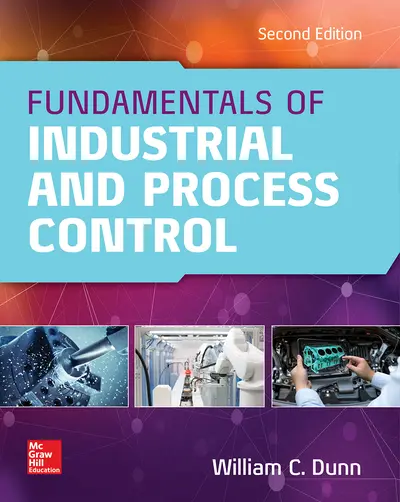My Account Details

ISBN10: 1265793654 | ISBN13: 9781265793654

Step 1 . Download Adobe Digital Editions to your PC or Mac desktop/laptop.
Step 2. Register and authorize your Adobe ID (optional). To access your eBook on multiple devices, first create an Adobe ID at account.adobe.com. Then, open Adobe Digital Editions, go to the Help menu, and select "Authorize Computer" to link your Adobe ID.
Step 3. Open Your eBook. Use Adobe Digital Editions to open the file. If the eBook doesn’t open, contact customer service for assistance.
Publisher's Note: Products purchased from Third Party sellers are not guaranteed by the publisher for quality, authenticity, or access to any online entitlements included with the product.
A Fully Updated, Practical Guide to Automated Process Control and Measurement Systems
This thoroughly revised guide offers students a solid grounding in process control principles along with real-world applications and insights from the factory floor. Written by an experienced engineering educator, Fundamentals of Industrial Instrumentation and Process Control, Second Edition is written in a clear, logically organized manner. The book features realistic problems, real-world examples, and detailed illustrations. You’ll get clear explanations of digital and analog components, including pneumatics, actuators, and regulators, and comprehensive discussions on the entire range of industrial processes.
Fundamentals of Industrial Instrumentation and Process Control, Second Edition covers:
• Pressure
• Level
• Flow
• Temperature and heat
• Humidity, density, viscosity, & pH
• Position, motion, and force
• Safety and alarm
• Electrical instruments and conditioning
• Regulators, valves, and actuators
• Process control
• Documentation and symbol standards
• Signal transmission
• Logic gates
• Programmable Logic controllers
• Motor control
• And much more
Acknowledgment
1 Introduction
Chapter Objectives
1.1 Introduction
1.1.1 History
1.2 Process Control
1.3 Definition of the Elements in a Control Loop
1.4 Process Facility Considerations
1.5 Units and Standards
1.6 Instrument Accuracy
Summary
Problems
2 Pressure
Chapter Objectives
2.1 Introduction
2.2 Basic Terms
2.2.1 Density
2.2.2 Impact Pressure
2.3 Pressure Measurements
2.4 Pressure Formulas
2.5 Measuring Instruments
2.5.1 Manometers
2.5.2 Diaphragms, Capsules, and Bellows
2.5.3 Bourdon Tubes
2.5.4 Other Pressure Sensors
2.5.5 Vacuum Instruments
2.6 Application Considerations
2.6.1 Selection
2.6.2 Installation
2.6.3 Calibration
Summary
Problems
3 Level
Chapter Objectives
3.1 Introduction
3.2 Level Formulas
3.3 Level Sensing Devices
3.3.1 Direct Level Sensing
3.3.2 Indirect Level Sensing
3.4 Application Considerations
Summary
Problems
4 Flow
Chapter Objectives
4.1 Introduction
4.2 Basic Terms
4.3 Flow Formulas
4.3.1 Continuity Equation
4.3.2 Bernoulli Equation
4.3.3 Flow Losses
4.4 Flow Measurement Instruments
4.4.1 Flow Rate
4.4.2 Total Flow
4.4.3 Mass Flow
4.4.4 Dry Particulate Flow Rate
4.4.5 Open Channel Flow
4.5 Application Considerations
4.5.1 Selection
4.5.2 Installation
4.5.3 Calibration
Summary
Problems
5 Temperature and Heat
Chapter Objectives
5.1 Introduction
5.2 Basic Terms
5.2.1 Temperature Definitions
5.2.2 Heat Definitions
5.2.3 Thermal Expansion Definitions
5.3 Temperature and Heat Formulas
5.3.1 Temperature
5.3.2 Heat Transfer
5.3.3 Thermal Expansion
5.4 Temperature Measuring Devices
5.4.1 Thermometers
5.4.2 Pressure-Spring Thermometers
5.4.3 Resistance Temperature Devices
5.4.4 Thermistors
5.4.5 Thermocouples
5.4.6 Semiconductors
5.5 Application Considerations
5.5.1 Selection
5.5.2 Range and Accuracy
5.5.3 Thermal Time Constant
5.5.4 Installation
5.5.5 Calibration
5.5.6 Protection
Summary
Problems
6 Humidity, Density, Viscosity, and pH
Chapter Objectives
6.1 Introduction
6.2 Humidity
6.2.1 Humidity Definitions
6.2.2 Humidity Measuring Devices
6.3 Density and Specific Gravity
6.3.1 Basic Terms
6.3.2 Density Measuring Devices
6.3.3 Density Application Considerations
6.4 Viscosity
6.4.1 Basic Terms
6.4.2 Viscosity Measuring Instruments
6.5 pH Measurements
6.5.1 Basic Terms
6.5.2 pH Measuring Devices
6.5.3 pH Application Considerations
Summary
Problems
7 Position, Motion, and Force
Chapter Objectives
7.1 Introduction
7.2 Position and Motion Sensing
7.2.1 Basic Position Definitions
7.2.2 ON/OFF Position Sensing
7.2.3 Motion and Distance Sensing
7.2.4 Rotation Sensing
7.2.5 Position Application Consideration
7.3 Force, Torque, and Load Cells
7.3.1 Basic Definitions of Force and Torque
7.3.2 Force and Torque Measuring Devices
7.3.3 Force and Torque Application Considerations
Summary
Problems
8 Safety and Alarm
Chapter Objectives
8.1 Introduction
8.2 Safety Hazards
8.2.1 Personnel Hazards
8.2.2 Environmental Hazards
8.2.3 Control Equipment Hazards
8.2.4 Process Equipment Hazards
8.3 Safety Sensors
8.3.1 Smoke and Fire Sensors
8.3.2 Heat Sensors
8.3.3 Gas Sensors
8.3.4 Artificial Senses Chemical Sensors
8.3.5 Radiation Detectors
8.4 Process Equipment Safety
8.4.1 Alarm and Trip Systems
Need support? We're here to help - Get real-world support and resources every step of the way.
Additional Resources
